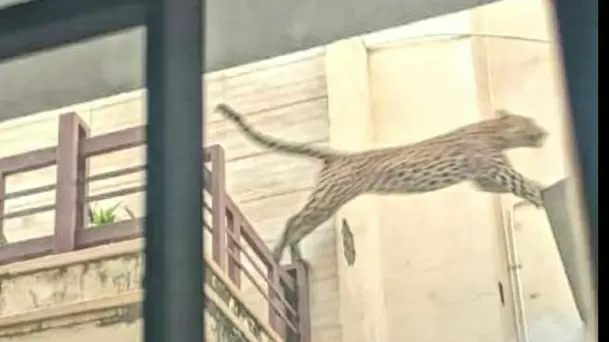Leopard numbers more than tripled around Jaipur, raising risk of conflicts
Jaipur
07-January-2023

Photo : IANS
With the leopard population more than tripling in two of Jaipur's forest habitats -- Jhalana leopard reserve and Ambagarh -- it has given rise to frequent man-animal encounters in urban areas, confirm forest officials.
Forest department officials said that Jhalana reserve witnessed the highest growth in the population of leopards over the years.
A source pointed out that there were 60 leopards across Jaipur's landscape, ranging from Jhalana to Kukas-Chandwaji along the road to Delhi.
Jhalana and the adjoining forest patches remain cut off by highways, residential localities.
Now the question is can this forest belt sustain such a large number of leopards? Was any carrying-capacity of predators and prey base study ever carried out by the authorities? Is a sufficient natural prey base available at Jhalana and other adjoining forest belts?
These are the questions which remain unanswered and the authorities smile off such questions. They are busy facilitating jeep safaris for visitors who now line up in advance for leopard sightings.
Watch This TWL Video
The in-charge of the safaris says that a leopard would need a prey animal twice a fortnight, if not per week.
So, around 40 of them would require a few thousand animals per year. He admitted shortage of prey-base in this forest. Since deer are not in good numbers, the leopard has to live on eggs of peacocks, catching peahens, and preying upon partridges.
It has also been reported surviving on rodents, which are in abundance.
Environmentalists told IANS that it is not easy for a leopard to pounce upon monkeys. Therefore, this predator often ends up remaining hungry. At night, it would enter residential colonies in search of street dogs, thereby endangering the lives of human beings.
According to Janeshwar Chaudhary, a Ranger at Jhalana leopard conservation, "The latest count suggests that there are 40 leopards in both Jhalana leopard conservation and Ambagarh leopard conservation in Jaipur."
Ambagarh is the second leopard conservation to come up after Jhalana in Jaipur. The two combined cover over 36 sq kms and they are separated by the Jaipur-Agra national highway.
Of the two, Jhalana with a 20 sq km area is the bigger as well as older leopard conservation where most of the 40 leopards live.
He said that ideally a 36 sq km area should have 10-12 leopards only but there are 40 leopards, more than what the forest could provide for.
Meanwhile, forest officials are clueless over the population explosion of this predator. Initially, they estimated their number to be 10 about six years ago, living in an area of nearly 22 sq km. However, they are now tightlipped when asked about the availability of their food, living conditions etc. And the result is frequent man-animal conflict, says an environmentalist on condition of anonymity. - IANS
More Headlines
Karnataka Withdraws CID Probe in Ranya Rao Gold Smuggling Case
New Kerala Guv Strikes Cordial Tone, Hosts CM Vijayan And FM Sitharaman In Delhi
Digital Payments Surge in India: 18,120 Crore Transactions in FY24-25
Weather Dept Predicts Heavy Rains In Several TN Districts
Chitra Subramaniam’s Book Boforsgate Exposes Arms Trade, Corruption, and Political Intrigue
Karnataka Withdraws CID Probe in Ranya Rao Gold Smuggling Case
New Kerala Guv Strikes Cordial Tone, Hosts CM Vijayan And FM Sitharaman In Delhi
Digital Payments Surge in India: 18,120 Crore Transactions in FY24-25
Weather Dept Predicts Heavy Rains In Several TN Districts
Chitra Subramaniam’s Book Boforsgate Exposes Arms Trade, Corruption, and Political Intrigue










